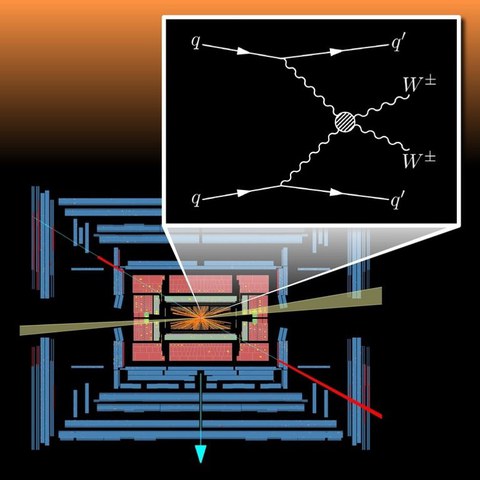Jul 06, 2018
Particle Physicists at TU Dresden involved in the discovery of scattering of W and Z bosons

Kandidat eines WW → WW Ereignisses mit zwei elektrisch gleich geladenen Myonen (rot) und fehlendem transversalen Impuls (cyan) der Neutrinos aus den W-Zerfällen, sowie zwei aus den abstrahlenden Quarks entstandenen Teilchenbündeln (gelb) im ATLAS-Detektor.
Particle physicists from Technische Universität Dresden, together with international research colleagues, have discovered an extremely rare process that can be compared to tiny lightsabers. At the ATLAS experiment at CERN in Geneva, the group is conducting research on messenger particles of the so-called weak interaction. They have shown that these particles interact with each other in a scattering process. These results have now been presented at the International Conference on High Energy Physics ICHEP2018 in Seoul.
Science Fiction writers have a passion for lightsabers. But this idea will probably remain a dream forever, because light consists of photons - in physics they are also called messenger particles of the electromagnetic interaction. According to the laws of physics, photons can only interact with objects that carry an electrical charge. Since they are electrically neutral themselves, they simply penetrate each other completely unaffected. That is why light beams can be crossed, but will never bend each other.
In contrast to the electromagnetic interaction, in the case of the nuclear "weak interaction", their messenger particles interact through scattering, since they themselves carry a weak charge. TU Dresden researchers, who are members of the ATLAS collaboration at CERN, have now doubtlessly observed the scattering of these particles, called W and Z bosons, in two different processes. This is one of the outstanding results presented at the International Conference on High Energy Physics ICHEP2018 in Seoul on July 5th, and for which research groups from China, USA, Canada, South Africa, the UK, Greece and France have collaborated intensively with the German researchers from Dresden, Freiburg, and DESY in Hamburg.
The groups analyzed ATLAS data from 2015 and 2016. The ATLAS detector records the collision products of protons that travel near the speed of light in the particle accelerator LHC and finally collide. W and Z particles can be radiated from quarks. However, due to their short lifetime, these quanta of "weak light", emitted by the quarks, are only able to fly a distance of 0.1 femtometre, that is, about 1/10 of a proton radius, before transforming into other particles. To be able to interact with each other, these ultra-short "lightsabers" have to approach each other by 0.002 femtometre (about 1/500 of a proton´s radius). Such an extremely improbable coincidence happens only about once in 20,000 billion proton-proton interactions.
Two PhD students from the Institute of Nuclear and Particle Physics were able to extract the signal from the "background noise". They found 60 candidates for scattering events WW à WW of like-sign charged W particles. This is more than three times what was seen in data from 2012, where ATLAS had obtained the first evidence for this process. Stefanie Todt has studied WW scattering in her doctoral thesis: “Together with Franziska Iltzsche, we turned every stone until we were sure that we had really discovered what we were looking for." Tim Herrmann, one of the two PhD students working on the search for the WZ à WZ scattering process, thanked his fellow PhD student who is currently on parental leave for 12 weeks: "As an analysis coordinator, Carsten Bittrich paved the way to this discovery up to the first draft of the publication, which was released yesterday by the entire ATLAS collaboration.” Thanks to a multivariate “BDT” analysis technique, ATLAS was able to isolate 44 scattering events.
Further investigation of the scattering process with more data could provide clues to new particles or substructures of known particles. Also, TUD researchers hope to gain new insights into the Brout-Englert-Higgs field: "Exactly six years after the discovery of the Higgs particle, we now have two processes at hand that will help us to better understand the properties of the new species of Higgs particles," says Michael Kobel, head of the Dresden group. "The Brout-Englert-Higgs field allows the scattering of the 'weak light' only at tiny distances between the W and Z particles. So it acts as a kind of shock absorber. An even more accurate measurement should check whether there are several damping Higgs particles, or whether they have a substructure and can even be excited. "
Original publications
- Observation of electroweak production of a same-sign W boson pair in association with two jets in pp collisions at Ös = 13 TeV with the ATLAS detector
ATLAS Conference Note ATLAS-CONF-2018-030 (4 July 2018)
https://atlas.web.cern.ch/Atlas/GROUPS/PHYSICS/CONFNOTES/ATLAS-CONF-2018-030/ - Observation of electroweak W±Z boson pair production in association with two jets in pp collisions at Ös = 13 TeV with the ATLAS detector
ATLAS Conference Note ATLAS-CONF-2018-033 (4 July 2018)
https://atlas.web.cern.ch/Atlas/GROUPS/PHYSICS/CONFNOTES/ATLAS-CONF-2018-033
Additional articles and videos
- “Quarks observed to interact via minuscule ‘weak lightsabers’”
Physics Briefing, ATLAS Collaboration https://atlas.cern/updates/physics-briefing/weak-lightsabers - „Zerstreute Teilchen“ (in German) at weltmaschine.de
https://www.weltmaschine.de/neuigkeiten/neuigkeiten_archiv/2018/zerstreute_teilchen/ - Videos:
https://youtu.be/wYrV3yia01c
https://youtu.be/4T62EPF2N_0
Information for journalists:
Prof. Dr. Michael Kobel
Institute of Nuclear and Particle Physics
Tel.: +49 (0) 351 463 39880
michael.kobel@tu-dresden.de
https://tu-dresden.de/mn/physik/iktp/arbeitsgruppen/teilchenphysik?set_language=en